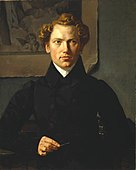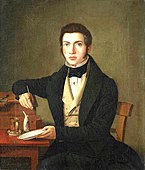Ferdinand Tellgmann
Johann Otto Carl Ferdinand Tellgmann (born September 24, 1811 in Bischhausen near Eschwege , † April 8, 1897 in Mühlhausen / Thuringia ) was a German portrait painter of the Biedermeier period and photographer .
He turned to the daguerreotype at an early stage and is considered to be the founder of the Tellgmann dynasty of photographers and his biography exemplifies the transition from portrait painting to portrait photography in the mid-19th century.
family
The painter and later photographer Tellgmann founded with his family "a photographer dynasty of sons, grandchildren, brothers-in-law and nephews" with a total of ten photographers, especially in northern Thuringia and northern Hesse: Born in 1811 as the son of the tenant August Tellgmann , married Ferdinand Tellgmann
- on July 9, 1843 Cäcilie , née Bregazzi (1825–1903), sister of the photographers Eduard and Christian Bregazzi .
- The first son August (1843–1912) was born before the marriage and later ran a textile shop in Mühlhausen.
The other sons
- Franz Tellgmann (born January 23, 1853; † 1933) and
- Oscar Tellgmann (born September 20, 1857 - † 1936)
Later continued the father's business, opened their own shops and rose to become court photographers as well as maneuver and war photographers . Up until the First World War, the two brothers were two of only four “official 'military photographers'”. However, no photographer from the Tellgmann family took part in further maneuvers after Adolf Hitler's war plans became known .
- Franz Tellgmann's son Paul took over the main business in Mühlhausen in 1930 and ran it until 1950.
- The (by marriage) nephew Otto Schulz (* 1870 in Berlin , † in 1952 Mühlhausen) was an architect and photographer during the First World War.
Career
Tellgmann contracted scarlet fever when he was two years old , which caused his eardrums to burst. As a result, he not only failed to learn the spoken language , but remained deaf and dumb for the rest of his life . Five years later, his parents placed the boy in the care of the then pastor of Altenburschla , who then personally took care of Tellgmann's school education. An artistic talent of the student became apparent early on . In 1827, Tellgmann was able to begin training at what was then the Electoral Academy in Kassel , where he specialized in portraiture.
Of the works from Tellgmann's student days, the Biedermeier painting Im Atelier from 1834 stands out, a " snapshot that vividly depicts the training and work situation of art students at that time."
"In Tellgmann's Biedermeier portraits, his great closeness to nature and the colourism trained on the old Dutch become clear."
After successfully completing his studies, he began working as a portrait painter from 1838 onwards, initially in his home region in Eschwege / Wanfried , where his parents now lived and where Tellgmann's father had also been given the post of Thurn- und Taxis postman as early as 1829 , as well as in Mühlhausen. After Tellgmann had received an order from a Mühlhausen banker for a portrait of his bride living in Eschwege, the result was so convincing that the painter was invited to Mühlhausen. It was there that Tellgmann finally founded his company F. Tellgmann on July 3, 1841, benefiting from the initially unrivaled situation as a portraitist and painter .
After Tellgmann had met Cäcilie while dancing in the White House in 1842, they married on July 9, 1843 after their first son August saw the light of day. Also in 1843, a few years after the invention of the "light image", the daguerreotype, is Tellgmann 1843 joined the working in Kassel photography pioneer Moses J. Landau to where he the secrets of that time still amazing " photo " graphy learned. The new photography technique, which was refined over the years, brought the young family a certain wealth.
Eight years after he began with his daguerreotypes, all of which were unique , and after the reproducible photographs that followed soon, Ferdinand Tellgmann painted again, in color and in oil: the one dated and signed to the year 1851 , today in the holdings of the university's art collection The painting Portrait of a Woman in Göttingen probably shows Tellgmann's wife Cäcilie . The portrait is an example of the "switch from portrait painting to portrait photography around the middle of the 19th century."
After Ferdinand Tellgmann had established a real photographer dynasty in his own family and through marriage policy, he retired from active business life as a senior in 1877 . He entrusted the management of his Mühlhausen company to his eldest son Franz, who had also previously been trained as a photographer. Franz opened a branch in Eschwege, which was soon run by his brother Oskar. He opened further branches in Bad Sooden , Wanfried an der Werra and Hersfeld, which, however, still bore his father's name until his father's death in 1897. In 1891 the senior was able to take part in the celebrations for the 50th anniversary of the founding of the F. Tellgmann company before he died six years later.
The company's founder's family policy continued to have an impact posthumously : in the meantime, his brother-in-law Christian Bregazzi founded the Christian Bregazzi publishing house in Langensalza around 1900 . Tellgmann's son Franz took over this publishing house with motif postcards . For example, a postcard that ran on January 2, 1910 with the imprint “Verlag Frz. Tellgmann, Hofphotogr. (Ex. Ch. Bregazzi) " documented .
Famous works
Four of the oil paintings shown are now in the collection of the Kassel Gemäldegalerie , the portrait of a woman is in the art collection of the University of Göttingen . Among the surviving photographs, the architecture and landscape photograph of the construction of the Lengenfeld Viaduct as part of the Leinefelde – Treysa railway line from around 1877 stands out.
- Portraits (MHK)
1834: Engraver
1837: porcelain painter
1851: Oil painting , probably Cäcilie , née Bregazzi
The preserved photo studio and a lost archive
"[...] Ferdinand Tellgmann's complete photo studio (one of the oldest in Germany)" can be found today in the Eschwege city museum . On the other hand, nothing is known about the “whereabouts of the huge negative archive ” of the traditional family business - it is considered lost.
literature
- Tellgmann, Ferdinand . In: Hans Vollmer (Hrsg.): General lexicon of fine artists from antiquity to the present . Founded by Ulrich Thieme and Felix Becker . tape 32 : Stephens – Theodotos . EA Seemann, Leipzig 1938, p. 512 .
- Thomas Wiegand : Atelier Tellgmann - Photographers in Eschwege 1881–1954. In: Eschweg history sheets. Volume 1, 1990, pp. 4-12.
- Thomas Wiegand: Ferdinand Tellgmann. Commercial portrayal in painting and photography around 1850. Jenior and Pressler, Kassel 1994, ISBN 3-928172-36-0 (also dissertation, Kassel University 1993).
- Andreas Felmeden: The award of court titles using the example of the “court photographer Sr. Majesty of the Emperor and King” Oscar Tellgmann. In: Orders and Medals. No. 39, October 2005, pp. 10–16, magazine of the German Society for Ordenskunde eV (DGO eV).
- Andreas Felmeden: From court photographer to photo reporter. The Tellgmann family of photographers through social change. In: Orders and Medals. No. 40, December 2005, pp. 5-9, magazine of the German Society for Ordenskunde eV (DGO eV).
Web links
- Ferdinand Tellgmann in the Photographers Wiki
Individual evidence
- ↑ a b c d e f g h i j k l m n o p q Oliver Krebs: Ferdinand Tellgmann… Beginning of a photographer dynasty on the eichsfeld-archiv.de website , accessed on January 23, 2015.
- ↑ a b Tellgmann, Ferdinand , image and text under the heading of the inventory catalog of 19th century paintings / Museumslandschaft Hessen Kassel on the museum-kassel.de page , accessed on January 24, 2015.
- ↑ a b Thomas T. Müller (responsible): 2009 / Time leaps - Mühlhausen pictures in a double focus / June 18, 2009–6. September 2009 / Museum am Lindenbühl , commentary on the exhibition of the same name on the website muehlhaeuser-museen.de by the Mühlhäuser Museum Association , accessed on January 24, 2015
- ↑ a b c Reiner Schmalzl: Precious rarities from Langensalza emerged / Bad Langensalza. On the Internet and at flea markets, rare testimonies from Langensalza keep surprising. Some things, however, there is not a bargain price on the page thueringer-allgemeine.de of 7 June 2014; last accessed online on 23 January 2015
- ↑ a b Andrea Fußstetter, Jörg Frieß, Mirko Wiermann (Red.): Oscar Tellgmann (1857–1936) & Gustav Tellgmann (1888–1973) on the dhm.de website of the German Historical Museum Foundation , accessed on January 24, 2015
- ↑ Marianne Heinz : Ferdinand Tellgmann, Das Atelier (1834) on the page altertuemliches.at of November 10, 2010 on the occasion of a lecture by the director of the New Gallery in Kassel , accessed on January 24, 2015
- ↑ Compare the captioning for the portrait of a porcelain painter on the museum-kassel.de page, accessed on January 24, 2015
- ↑ a b c d Christian Scholl, Anne-Katrin Sors (ed.): Academic rigor and artistic freedom. The paintings of the 19th century in the art collection of the University of Göttingen. Inventory catalog , Göttingen: Universitäts-Verlag Göttingen, 2013, ISBN 978-3-86395-102-3 ; (Reading sample, books.google.de ).
- ^ Manfred Lippert: The printing and publishing industry in (Bad) Langensalza 1680-2010. A historical overview , 1st edition, Bad Langensalza: Rockstuhl, 2010, ISBN 978-3-86777-112-2 ; Extract u. a. of the foreword , table of contents , preview of the keyword Bregazzi
- ↑ Inventory catalog of 19th century paintings / Museumslandschaft Hessen Kassel ( Tellgmann must be re-entered in the search field), accessed on January 24, 2015
- ↑ Stadtmuseum Eschwege / In the Eschweger Stadtmuseum you can see ... on the page eschwege.de , accessed on January 24, 2015
| personal data | |
|---|---|
| SURNAME | Tellgmann, Ferdinand |
| ALTERNATIVE NAMES | Tellgmann, Johann Otto Carl Ferdinand (full name) |
| BRIEF DESCRIPTION | German portrait painter of the Biedermeier period and photographer |
| DATE OF BIRTH | September 24, 1811 |
| PLACE OF BIRTH | Bischhausen near Eschwege |
| DATE OF DEATH | April 8, 1897 |
| Place of death | Mühlhausen / Thuringia |







